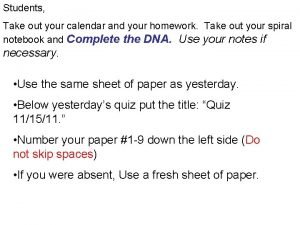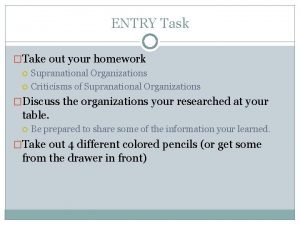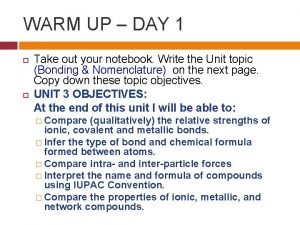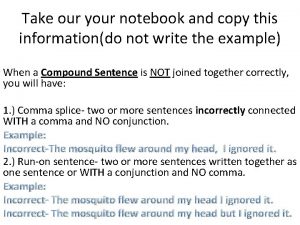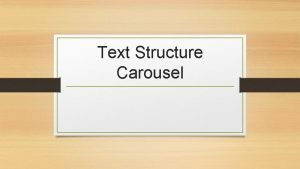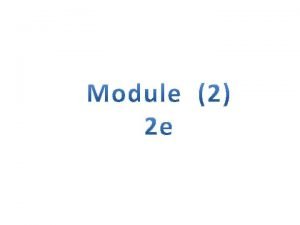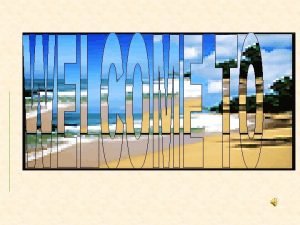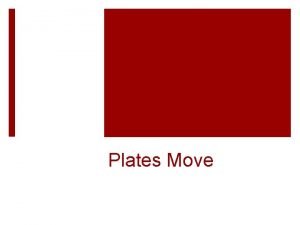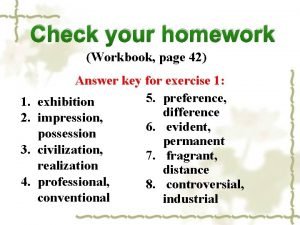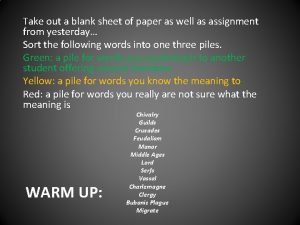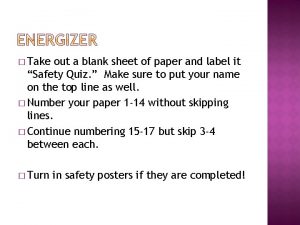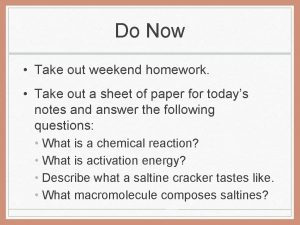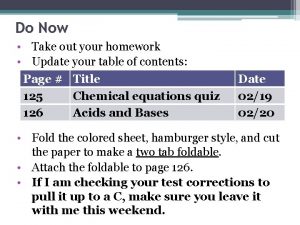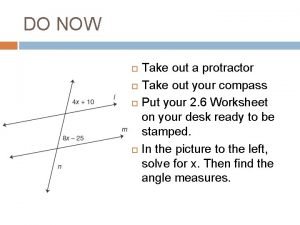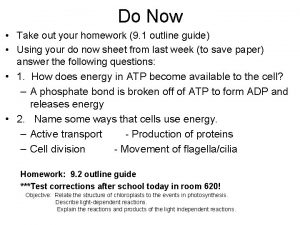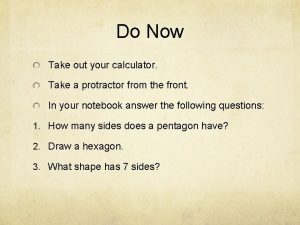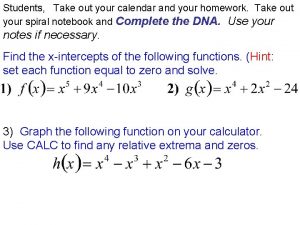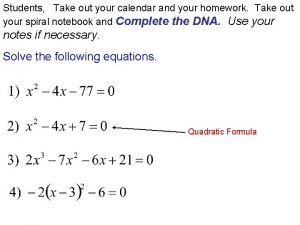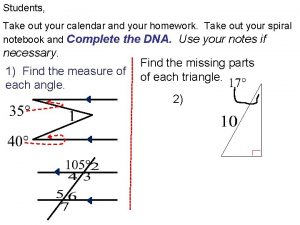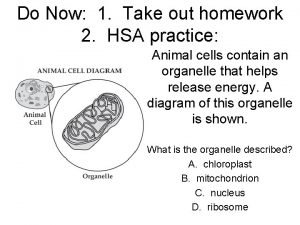Do Now Take out your homework n Take






















































- Slides: 54

Do Now Take out your homework. n Take out a sheet of paper (or your notebook) and answering the following questions: n What did you do this Thanksgiving? n What is happening in this picture? n

Discovery of DNA, DNA Structure and Function

I. Why should I care about DNA?

II. Nucleic Acids Review What is the function of nucleic acids? To store genetic information. n What are the monomers of nucleic acids? Nucleotides n There are two major types of nucleic acids: deoxyribonucleic acid or DNA and ribonucleic acid or RNA. n

III. Function of DNA n What does DNA do? DNA contains the instructions for making proteins; it stores the genetic information

IV. Location of DNA The DNA in a prokaryotic cell is located in the ( cytoplasm / nucleus ) of the cell. n The DNA in a eukaryotic cell is located in the ( cytoplasm / nucleus ) of the cell. In eukaryotic cells, DNA cannot leave the nucleus. n DNA in the nucleus is wound up really tightly around proteins into a chromosome n

V. What is DNA made of? Deoxyribonucleic acid is a nucleic acid made up of millions of tiny subunits called nucleotides n A nucleotide is made of 3 parts: 1. Phosphate group 2. Sugar group (called a pentose group) 3. Nitrogenous base n

V. What is DNA made of? n Picture of a nucleotide:

Sugar in DNA n What is the pentose sugar in ever DNA nucleotide? Deoxyribose

VI. DNA Structure n DNA is a polymer of four nucleotide monomers. A DNA nucleotide is identified by the base it contains: Adenine (A), Thymine (T ), Guanine (G), and Cytosine (C).

Nucleotides There are 4 Types of Nucleotides A T Adenine Thymine C G Cytosine Guanine

VI. DNA structure n The phosphate and sugar part of the nucleotide form the backbone of the DNA molecule n The nitrogenous bases form the “rungs” of the DNA ladder

Sides of the Ladder n To form the sides of the ladder, the phosphate group of one nucleotide covalently bonds to the sugar of another 13

Structure of DNA Review STOP! n Work on practice questions A on worksheet for 5 minutes n

The Discovery of DNA Timeline n 1949, Erwin Chargaff’s research showed that in the DNA from one organism, the amount of adenine always equals the amount of thymine and the amount of guanine always equals the amount of cytosine. This suggested that nucleotides in DNA must be paired up.

2 Types of Nucleotides (1) Purines : n n n Are big double ring nucleotides Adenine, Guanine Hint: Pure As Gold (2) Pyrimidines: n Are smaller single ring nucleotides Cytosine, thymine n Hint: Cut The Pye n

Base Pairing Each base will only bond with one other specific base. The bonding between a nuleotide base and its partner is called base pairing. n A Purine will only bond with a Pyrimidine n Adenine (A) and Thymine (T) form a base pair n Cytosine (C) and Guanine (G) will form a base pair n


Check for Understanding The DNA molecule is in the shape of a double helix or twisted ladder. n The sides of the ladder are made of what? Phosphate groups, n pentose sugar n The rungs of the ladder are made of what? Nucleotide

VI. DNA Structure n The nucleotides are attached together by Hydrogen Bonds n There are 3 hydrogen bonds between C and G, 2 between A and T

Practice Work on questions in section B! n 5 minutes n

DNA v. RNA

Video DNA Structure: n https: //www. youtube. com/watch? v=qy 8 dk 5 i. S 1 f 0 n https: //www. youtube. com/watch? v=d 7 ET 4 bb k. Tm 0 n

VI. DNA Structure Phosphate Sugar Nitrogen Base


Do Now 1. 2. 3. Take out your homework. What is the complementary strand of DNA to: ATC GTA CCA ATG Which of the following base pairings is more stable and why? 1. 2. 4. Adenine bound to Thymine Guanine bound to Cytosine What is your favorite cop/forensic science show? (ie. // Bones, NCIS, Castle are mine)


PCR + Why it matters?

I. DNA Review What are three components that make up a nucleotide? n Which side is the 5’ end? n How many hydrogen bonds are n

II. DNA Replication n Before a cell goes through mitosis (cell division), what must happen to the DNA? n The DNA must replicate n Why must DNA be replicated? n So that each cell has a copy of the DNA

VII. DNA Replication n DNA replication is the process of copying DNA prior to cell division.

VII. DNA Replication n Step 1: Enzymes unwind and unzip the DNA double helix. The enzyme helicase breaks the weak hydrogen bonds between the bases.

VII. DNA Replication n Step 2: The enzyme DNA polymerase brings complementary DNA nucleotides to bond with free nucleotides on the original DNA molecule.

VII. DNA Replication n Step 3: Two double stranded DNA molecules that are identical to each other are produced.

More Vocabulary n The old DNA strand is called the template strand n The new DNA strand is called the complementary strand

VII. DNA Replication n What step of DNA replication is this?

VII. DNA Replication n What step of DNA replication is this?

VII. DNA Replication n What step of DNA replication is this?

VII. DNA Replication n What step of DNA replication is this?

VII. DNA Replication n What step of DNA replication is this?

VII. DNA Replication n What step of DNA replication is this?

Videos n http: //highered. mcgrawhill. com/olcweb/cgi/pluginpop. cgi? it=swf: : 535: : /sites/dl/free/0072437316/120076/micr o 04. swf: : DNA%20 Replication%20 Fork

II. DNA Replication

DNA Replication Video 2


Objectives n. SWBAT define the term DNA n. SWBAT describe the history and function of DNA

The Discovery of DNA Timeline n n 1860’s-Gregor Mendel does pea plant experiments. Mendel was an Austrian monk who experiment on pea plants. He is known as the father of genetics

The Discovery of DNA Timeline n n 1940’s-Scientists knew that chromosomes were made of DNA and proteins. 1944 -Avery identified DNA as a carrier of genes.

n 1952 Hershey and Chase confirmed that DNA was the genetic material.

The Discovery of DNA Timeline n 1953 -Maurice Wilkins and Rosalind Franklin developed X-ray diffraction photographs of the DNA molecule. Franklin determined that the DNA molecule looked like a tightly coiled spiral or helix composed of two or three strands of nucleotides.

The Discovery of DNA Timeline n 1953 - James Watson and Francis Crick used their knowledge of chemical bonding and the data gathered by many years of research by many scientists to conclude that the shape of the DNA molecule was a double helix or twisted ladder. DNA is made of two strands of nucleotides twisted around a central axis.

The Discovery of DNA Timeline n 1953 - James Watson and Francis Crick made a 3 -D model of DNA.

The Discovery of DNA Timeline n 1962 -Watson and Crick were awarded the Nobel Prize in Medicine and Physiology for determining the structure of DNA.

The Discovery of DNA Timeline n Today-Gene technology is used in paternity cases, crime scene investigations, making food, cloning, creating new medicines and many other exciting ways!
 Take out your homework
Take out your homework Take out your homework
Take out your homework Friction
Friction Take out your homework
Take out your homework Take out your homework
Take out your homework Take out your homework
Take out your homework Take out your homework
Take out your homework Take out your homework
Take out your homework Take out your homework
Take out your homework Take out your homework
Take out your homework Songs with poetic devices
Songs with poetic devices Take out your notebook
Take out your notebook Take out your notebooks
Take out your notebooks Take out your notebook
Take out your notebook Take out your notebook
Take out your notebook Take a point o on your notebook
Take a point o on your notebook Take out your notebook
Take out your notebook Copy in your notebook or on your notebook
Copy in your notebook or on your notebook Homework oh homework i hate you you stink
Homework oh homework i hate you you stink Homework oh homework i hate you you stink
Homework oh homework i hate you you stink Parts of a poem
Parts of a poem Homework i love you poem
Homework i love you poem Alitteration definition
Alitteration definition Literal language example
Literal language example Now i see it now you don't
Now i see it now you don't Put your right foot in put your right foot out
Put your right foot in put your right foot out Act out the following dialogue
Act out the following dialogue My soul cries out hallelujah
My soul cries out hallelujah Give us your hungry your tired your poor
Give us your hungry your tired your poor Take a bus or take a train
Take a bus or take a train Homework-finish-your-tomorrow
Homework-finish-your-tomorrow Being a clown isn't all fun and games summary
Being a clown isn't all fun and games summary How often do you answer your homework
How often do you answer your homework Please put your homework my desk
Please put your homework my desk Did you finish your homework sally
Did you finish your homework sally Your homework please
Your homework please Please hand in your homework
Please hand in your homework When do you do your homework
When do you do your homework Maggie hi tom have you finished your homework
Maggie hi tom have you finished your homework Lets check your answers
Lets check your answers Turn in your homework
Turn in your homework Turn in your homework
Turn in your homework Write down your homework
Write down your homework Hand your homework
Hand your homework Comic strip about plate movement
Comic strip about plate movement Please hand in your homework
Please hand in your homework Check your homework
Check your homework Write down your homework
Write down your homework Hand in your homework
Hand in your homework War of 1812 cast your vote
War of 1812 cast your vote Medeatakeout
Medeatakeout Ambers neighborhood asl
Ambers neighborhood asl Take out a sheet of paper
Take out a sheet of paper Take out a sheet of paper
Take out a sheet of paper Translate the following sentences into spanish
Translate the following sentences into spanish







